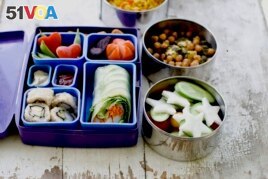16 August 2021
From VOA Learning English, this is the Health & Lifestyle report.
In many places around the world, children are preparing to go back to school. Those preparations usually include new school clothes, school supplies and a lunch box!
The right food containers can make packing lunches easier for parents. They can preserve the taste of food. And these days, they are made of materials that may help the environment.
In addition, for students who have been learning (and eating lunch) at home, new food containers may also make lunchtime at school more enjoyable.
A reporter for the Associated Press (AP) recently wrote about the growing choices for children's lunch boxes.
Years ago, a packed lunch included a sandwich, a piece of fruit, some carrots, and maybe some potato chips. These foods were usually packed in plastic bags that kids would throw away.
These days, the food in packed lunches is likely to be more interesting and so are the containers. Reusable lunch containers are already popular in many countries, including the United States. But now there are many more choices.

A Japanese bento box and Indian food container offer a multinational styles for lunch containers. (AP Photo)
In the U.S., the popularity of bento lunch boxes continues to grow. These Japanese lunch containers keep food separate and are reusable. And usually they come in bright colors.
There are also containers with tops that do not leak liquids. So, a child can bring soup. And some containers are insulated, meaning they keep hot food hot and cold food cold. So, students can have a real homecooked lunch. Parents can pack food from dinner the night before. This can be a real timesaver.
Many parents today choose reusable containers instead of single-use plastic ones that are thrown away. This creates less waste.
And containers made from sustainable materials are also becoming more popular.
Instead of using plastic wrap, some parents choose reusable wrappers made from beeswax. The warmth of your hands softens the beeswax so it can wrap around food. When you get home, you can wash it and use it again. You can also use it for storing things in the refrigerator.
Some storage bags made from silicone can be washed in a dishwashing machine, heated in a microwave oven, and stored in the freezer. These containers come in many shapes, sizes and colors.
There are also more reusable eating utensils, such as forks, spoons and drinking straws. And don't forget reusable water bottles! They are sold in many different styles and colors to please any school kid.
The AP reporter Katie Workman says it is up to "parents, to train the next generation to remember to bring everything home to wash and reuse." However, that might not be easy considering some of the most common things in a school's lost-and-found are lunch containers.
Cost is a big concern for most parents. Many companies now offer different kinds of containers at different prices -- from low-cost to high-priced choices.
And most are now made without a chemical called BPA that is often used in plastics. This chemical could get into food and into the body. This may create health concerns to some people.
Besides containing BPA, there is another problem with older lunch boxes: They only have one compartment. So, all the food moves around and can get damaged -- like an apple rolling onto your sandwich. Now, there are lunch boxes with smaller, movable compartments. So, depending on the meal, you can keep things separate and undamaged.
These choices can make lunch healthier and more fun for kids. And some show that you are thinking about the environment.
And that's the Health & Lifestyle report. I'm Anna Matteo.
Katie Workman wrote this story for the Associated Press. Anna Matteo adapted it for VOA Learning English. Mario Ritter, Jr. was the editor.
---------------_____
Words in This Story
pack –v. to put things into a container to be transported or for storage
sustainable –adj. involving methods that do not completely use up or destroy natural resources
wrap –n. a material used for covering and storing things
refrigerator –n. a device that is used to keep food cold
silicone –n. a chemical compound that does not let water or heat pass through
style –n. a particular way in which something is done
compartment –n.an enclosed space that is within a larger container or structure










